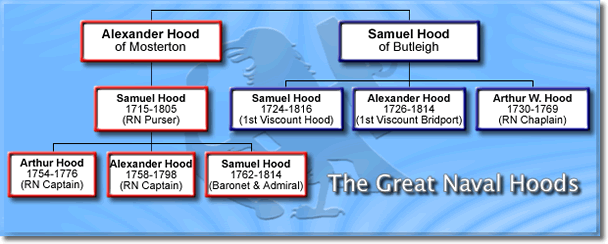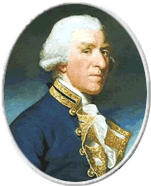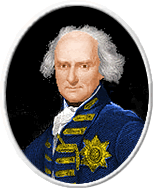Background
It all started with two brothers, Alexander and Samuel Hood. Alexander, the elder brother, settled in Mosterton. Samuel became vicar of Butleigh Parish. It was from Samuel's line that the first great naval Hoods, Samuel, 1st Viscount Hood, and Alexander, 1st Viscount Bridport, arose. Vicar Samuel also had another son that saw Royal Navy service, if only briefly, Vicar Arthur William Hood.
Alexander of Mosterton had a son named Samuel who saw naval service as a purser. Purser Samuel spawned three great naval Hoods: Admiral Sir (Baronet) Samuel Hood and Captains Alexander and Arthur Hood. The three were true fighting men that gave their all in the service of the Crown.

Shown above is a shortened version of the family tree (only the two brothers and their subsequent naval offspring are shown).
There were of course other naval Hoods that followed, most notably Admiral Sir Arthur William Acland Hood (1st Lord of the Admiralty, 1885-89) and Rear-Admiral Sir Horace Hood who died aboard battle cruiser Invincible at Jutland.
Which Hood was the Ship Named After?
The Mighty Hood was not, as some believe, named specifically after Sir Horace Hood who died at Jutland. Neither was she named specifically after the late 1880s First Sea Lord Sir Arthur Hood of Avalon. She was in fact, (officially at least) named for the first of the great naval Hoods, 1st Viscount Hood of Whitley (Lord Samuel Hood). This fact is verified by the names of her cancelled sister ships (all of whom were named for famous admirals of the 1700s). Of course, it is true that the battle cruiser was christened by the widow of Sir Horace Hood and used the bell (bearing an inscription regarding Sir Horce and Jutland) of the previous H.M.S. Hood. So, it could also be argued that as an "Admiral" class vessel, she was named after all three Hood admirals. It can also be argued that she was named after the family due its many excellent naval officers and their contributions.
The family continues to thrive. There have been eight Viscounts Hood to date. These are as follows:
- Samuel Hood, 1st Viscount Hood (1724-1816)
- Henry Hood, 2nd Viscount Hood (1753-1836)
- Samuel Hood-Tibbits, 3rd Viscount Hood (1808-1846)
- Francis Wheler Hood, 4th Viscount Hood (1838-1907)
- Grosvenor Arthur Alexander Hood, 5th Viscount Hood (1868-1933)
- Samuel Hood, 6th Viscount Hood (1910-1981)
- Alexander Lambert Hood, 7th Viscount Hood (1914-1999)
- Henry Lyttleton Alexander Hood, 8th Viscount Hood and Patron of the H.M.S. Hood Association (born 1958)
![]()
Below you will find timeline/biographies of the most famous early naval Hoods.
I. Sons of Vicar Samuel Hood of Butleigh

1st Viscount Hood of Whitley, Lord Samuel Hood
12 December 1724: Born in Butleigh, Somerset, to Vicar Samuel Hood and his wife Mary.
1740/1741: Entered Royal Navy. Posted to H.M.S. Romney as servant to Capt Thomas Smith. Advanced to Able Seaman under Romney's next master, Capt Thomas Grenville.
April 1743: Transferred to H.M.S. Garland.
November 1743: Posted to H.M.S. Sheerness under Captain George Rodney. Advanced to midshipman.
September 1744: Transferred to H.M.S. Ludlow Castle (under Capt Rodney once more).
January 1746: Assigned to H.M.S. Exeter under Commodore Thomas Smith. Hood was soon appointed lieutenant and posted to H.M.S. Winchelsea under Capt Henry Dyve.
November 1746: Lightly wounded (hand) during an engagement with French frigate Subtile (the Subtile surrendered and was later brought into the Royal Navy as H.M.S. Amazon).
March 1748: Appointed to H.M.S. Greenwich under Capt John Montagu. Later in the year Hood was posted to H.M.S. Lyon.
November 1748: Lyon paid-off. Hood placed on half-pay.
1749: Married Susannah Linzee, daughter of Portsmouth's Mayor.
January 1753: Posted to H.M.S. Invincible guard ship in Portsmouth.
May 1753: Posted to H.M.S. Terrible.
1754: Promoted to commander at the young age of 30. Assigned to sloop H.M.S. Jamaica. Served in North American waters.
July 1756: Posted to H.M.S. Lively.
1756: Made Post-Captain of H.M.S. Grafton.
January-May 1757: Took temporary command of three ships: H.M.S. Torbay (January), H.M.S. Tartar (01 April) and H.M.S. Antelope (30 April). In May, aboard Antelope, he helped wreck the French ship Aquilon and capture at least two privateers.
July 1757: Captain of frigate H.M.S. Bideford under Sir Edward Hawke.
February/March 1758: Captain of H.M.S. Vestal under Sir Edward Hawke. Participated in the attacks on the Isle of Aix.
21 February 1759: While enroute to North America, engaged and captured the French frigate Bellona
July 1759: Served under Lord Rodney in the bombardment of Havre de Grace.
1760-1763: Assigned to primarily convoy escort duties aboard H.M.S. Levant in the Mediterranean. Also served off Ireland.
1763: Levant paid-off. Hood given command of H.M.S. Thunderer guard ship at Portsmouth.
April 1767: Appointed Commander-in-Chief of His Majesty's ships on the New England station in North America. Commanded Romney.
1771-1773: Commanded H.M.S. Royal William guard ship at Portsmouth.
1773-1776: Commanded H.M.S. Marlborough. Following a devastating and fatal magazine explosion, Marlborough was taken out of service. Hood transferred to H.M.S. Courageux.
January 1778: Appointed Commissioner at Portsmouth and made Governor of the Naval Academy.
20 May 1778: Created a baronet by King George III during the King's visit to Portsmouth.
September 1780: Promoted to Rear-Admiral of the Blue.
1781: Hood, in command aboard H.M.S. Barfleur, was assigned a squadron and sent to support Lord Rodney against the French in the West Indies and off North America. Participated in numerous skirmishes with the French. The most notable achievement was the defeat and capture of the French warship Ville de Paris was captured. Captured two other vessels as well.
September 1782: Created as Baron Hood of Catherington.
1784-1788: Served as M.P. for Westminster (Tory)
April 1786-1789: Appointed Commander-in-Chief at Portsmouth (aboard Barfleur).
September 1787: Promoted to Vice-Admiral
1788-1795: Served as a Lord of the Admiralty.
1789-1790: Served as MP for Reigate
February 1793: Appointed Commander-in-Chief of the Mediterranean Station following the outbreak of the French Revolution. Took command of H.M.S. Victory and directed the capture of Toulon and Corsica.
1794: Promoted to Admiral of the Blue. Returned to England late in the year.
1795: Promoted to Admiral of the White. Retired from active naval service. Made an elder brother of Trinity House.
March 1796: Appointed Governor of Greenwich Hospital
June 1796: Created a peer in Great Britain as Viscount Hood of Whitley, Warwick.
27 June 1816: Lord Hood died in Bath on 27 June 1816, aged 92 years.
- It should be noted that not only have ships been named for Lord Hood, but a valley, river and mountain as well (Mount Hood region in the USA/Canada Pacific Northwest). It should also be noted that Lord Hood headed the board of enquiry into the famous mutiny aboard H.M.S. Bounty (Lieutenant William Bligh commanding).
For another look at Lord Hood's service visit http://www.aboutnelson.co.uk/hood.htm
![]()

1st Viscount Bridport, Admiral Alexander Hood
02 December 1726: Born in Butleigh, Somerset, to Vicar Samuel Hood and his wife Mary.
1740/1741: Entered Royal Navy (at same time as older brother Samuel).
1746: Appointed lieutenant (at same time as brother Samuel).
1756: Promoted to Commander. Soon afterward, he became Flag Captain of H.M.S. Minerva under Admiral Saunders. He was assigned to the Mediterranean. Saw action Quiberon Bay and the Bay of Biscay. Captured the Warwick (former English ship previously captured by the French).
1778: In command of H.M.S. Robust.
September 1780: Promoted to Rear Admiral of the Red Squadron (at the same time brother Samuel became Rear Admiral of the Blue).
1782: Commanding from H.M.S. Queen (under Lord Howe), participated in the relief of Gibraltar.
1787: Promoted to Vice Admiral.
1793: Commanded from H.M.S. Royal George (2nd in command to Lord Howe).
1794: Participated in the "Battle of the Glorious 1st of June." For his daring, he was created "Baron Bridport."
1795: Participated in the battle of Lorient. Captured 3 French warships.
1795-1800: Commander of the Channel Fleet. Retired and was created as "Viscount Bridport" in 1800.
1814: Passed away.
![]()
Vicar Arthur William Hood
December 1730: Born in Butleigh, Somerset, to Vicar Samuel Hood and his wife Mary. Educated at Ilminster Grammar School and St. John's College, Cambridge.
February 1755: Ordained a priest by the Bishop of London.
December 1755: Entered the Royal Navy. Served as chaplain aboard H.M.S. Trident until May 1756 (had to take convalescent leave due to poor health).
November 1757: Assigned as chaplain of H.M.S. Montague.
April 1759: Reassigned as chaplain of H.M.S. Hercules.
January 1760: Reassigned to a land post at Embden.
March 1761: Left Navy due to poor health (respiratory-related).
April 1761: Assumed vicarage of Butleigh after the post was vacated by his father Samuel (who move to Thorncombe).
23 November 1769: Died due to his recurring bouts with respiratory illness.
II. Son & Grandsons of Alexander Hood of Mosterton
Purser Samuel Hood
1715: Born to Alexander Hood of Mosterton.
April 1761: Entered the Royal Navy (at an advanced age). Served as a purser/pay master aboard H.M.S. Druid until November 1765.
November 1765-July 1772: Served as purser/pay master aboard H.M.S. Alarm.
August 1772: Reassigned (again as purser) to guard ship H.M.S. Elizabethat Portsmouth.
Date Unknown: Retired from Royal Navy and returned to Kingsland.
October 1805: Passed away.
![]()
Captain Arthur Hood
December 1753/January 1754: Born to Samuel Hood of Kingsland.
June 1767 - March 1771: Entered the Royal Navy. Assigned to H.M.S. Glasgow.
March - May 1771: Reassigned to H.M.S. Royal William. Served under 2nd cousin Captain (later 1st Viscount) Samuel Hood.
May 1771 - May 1773: Served aboard H.M.S. Diana.
May 1773: Assigned to H.M.S. Princess Amelia.
June 1773: Assigned to H.M.S. Portland.
September 1774: Assigned to H.M.S. Marlborough.
February 1775: Returned to H.M.S. Portland.
November 1775:Promoted to lieutenant.
August 1776: Given command of H.M.S. Pomona.
07/08 September 1776: Died while enroute to St Pierre, Martinique: Pomona was lost with all hands during a fiercely violent storm.
![]()
Captain Alexander Hood
23 April 1758: Born in Kingsland to Samuel and Anne Hood.
1767: Entered Royal Navy. Assigned to H.M.S. Romney under his 2nd cousin Captain (later 1st Viscount Hood) Samuel Hood.
January 1771: Assigned to yacht Katherine (possibly under command of 2nd cousin, the future Viscount Bridport, Captain Alexander Hood). Appointed lieutenant (at same time as brother Samuel).
1772 - 1775: Assigned to H.M.S. Resolution under legendary Captain James Cook. Participated in Cook's second epic cruise 'round the world. Note: He even had an island named after him- "Hood's Island."
August 1775 - February 1776: Assigned to H.M.S. Marlborough (stationed in North American waters under Lord Howe).
July 1777: Promoted to lieutenant.
March 1780: Placed in command of cutter Ranger. Ranger was assigned to the West Indies under Admiral Sir George Rodney.
May 1781: Promoted to commander.
July 1781: Made Flag-Captain of H.M.S. Barfleur under 2nd cousin Admiral Sir Samuel Hood (later 1st Viscount Hood). Saw action at Cape Henry (Sept 1781) and St. Kitts (Jan 1782).
January 1782: Appointed to frigate H.M.S. Champion. Saw action at Dominica (Apr 1782). Captured French ship Ceres.
Late 1782: Transferred to captured French ship Amiable. Sailed Amiable back to England in mid 1783.
1790 - 1793: Commanded frigate H.M.S. Hebe. Assigned to Channel Fleet.
1794: Commanded frigate H.M.S. Audacious temporarily. Had to relinquish command due to poor health.
1797: Resumed active naval career. Given command of H.M.S. Mars.
21 April 1798: Died during battle between Mars and French warship Hercule. Hood was shot in the thigh shortly after the action commenced. The ball severed his femoral artery resulting in a fatal wound. Captain Hood died just as the French ship surrendered.
![]()
Admiral Sir Samuel Hood
27 November 1762: Born in Kingsland to Samuel and Anne Hood.
1776: Entered Royal Navy and was assigned to H.M.S. Courageux. Courageux was commanded by 2nd cousin Captain (later 1st Viscount) Samuel Hood.
1778: Transferred to H.M.S. Robust under 2nd cousin Captain (later Viscount Bridport) Alexander Hood.
1779 - 1780: Served in Channel Fleet aboard sloop Lively.
October 1780: Reassigned to H.M.S. Barfleur in West Indies. Barfleur was the command ship of 2nd cousin Admiral Sir Samuel Hood.
1781: Promoted to lieutenant. Saw action against the French Navy (Count De Grasse) at Martinique (APR 1781), Cape Henry (Sept 1781), St Kitts (Jan 1782), Dominica (APR 1782) and Mona Passage (APR 1782).
1782: Appointed to Renard. Returned in her to England in 1782/1783.
1783 - 1785: Lived/studied in France.
1785: Returned to England. Appointed to the sloop H.M.S. Weasel.
1788 - 1789: Commanded frigate H.M.S. Thisbe.
1790 - 1794: Commanded frigate H.M.S. Juno. Note: In Feb 1791, while Juno was in St Anne's Harbour, Jamaica, Hood personally rescued 3 wrecked sailors during a particularly violent storm. For his personal bravery he was awarded a 100 guinea sword by the Jamaican House of Assembly. Hood saw action at Toulon and Corsica in 1793 (Juno was then under Lord Howe and the Mediterranean Fleet). A very interesting thing happened to Hood during this campaign: The English fleet had occupied the harbour/port at Toulon until French ground forces took the city. The Royal Navy ships immediately departed. Hood had been off on a separate mission at the time of the withdrawal. Having completed his mission, he proceeded back to Toulon. After some rather clever tricks by the French to convince him the port was still in English hands, Hood realised the truth. Under fire from French guns, he cut his anchor cables and left the scene...a very narrow escape indeed.
1794 - 1796: In command of frigate H.M.S. Aigle.
April 1796: Transferred to ship of the line H.M.S. Zealous. Served under Admirals Jervis and Troubridge. Also served under Lord Nelson at the Battle of the Nile and in the defence of Salerno. Note: At the Battle of the Nile, Zealous defeated the French ship Guerrier. Nelson was highly impressed by Hood's actions and left him in charge of the blockade against French forces in Egypt.
May 1800: Transferred to H.M.S. Courageux under Sir John Warren.
January 1801: In command of H.M.S. Venerable under Sir James Saumarez. Saw action at Algeciras in July. Venerable was heavily damaged during action shortly thereafter and had to be paid off.
1802: Now a commander, Hood became Commander-in-Chief of the Leeward Islands. Aboard H.M.S. Centaur, Hood helped capture Trinidad & Tobago, plus saw action supporting efforts at Demerara, Essequibo, Berbice and Suriname. His forces captured many enemy ships.
25 September 1805: Hood was seriously wounded during an engagement with French ships off Rochefort. He was shot by a musket in the right elbow. The arm had to be amputated. Even so, Hood's force captured 4 frigates during the action.
October 1807: Promoted to Rear-Admiral (still commanding from Centaur). Made second in command of Baltic Fleet.
August 1808:Assigned to H.M.S. Implacable. Attached to the Swedish Fleet, Implacable captured then destroyed the Russian warship Sewolod.
April 1809: Created a baronet.
1809 - 1811: Commanded elements in the Mediterranean theatre.
August 1811: Promoted to Vice Admiral. Appointed shortly thereafter to be Commander-in-Chief of the East Indies.
24 December 1814: Died at Madras following days spent in a high fever.
III. Highly Recommended Hood Family-Related Internet Sites: